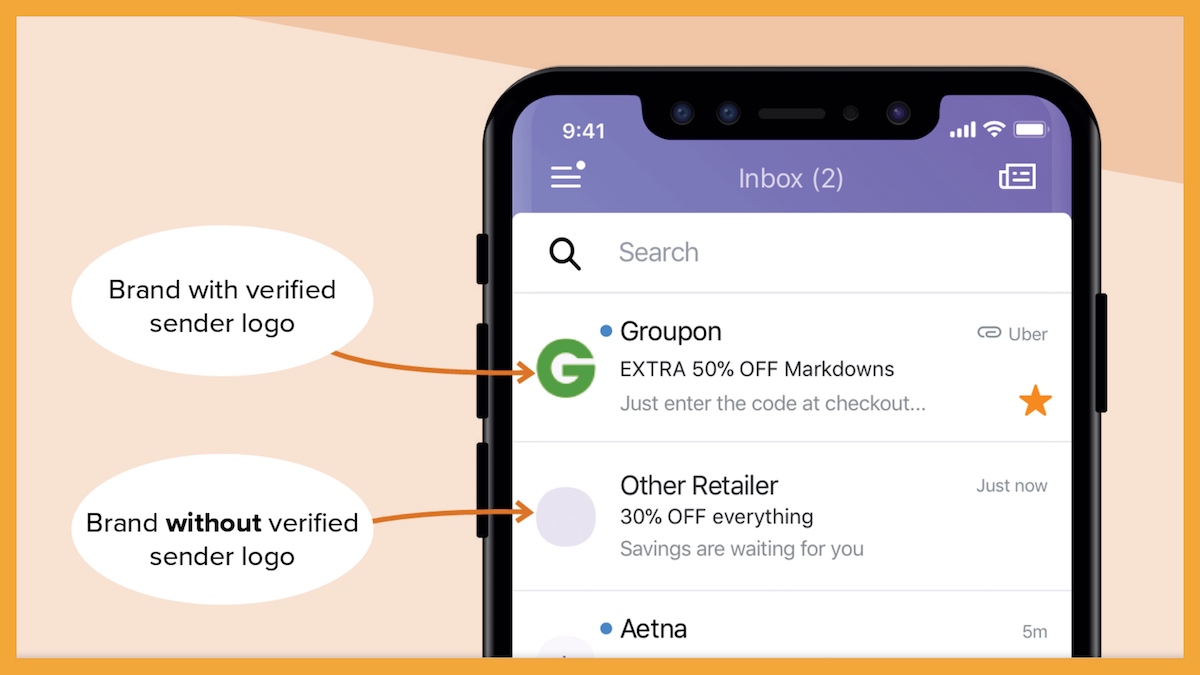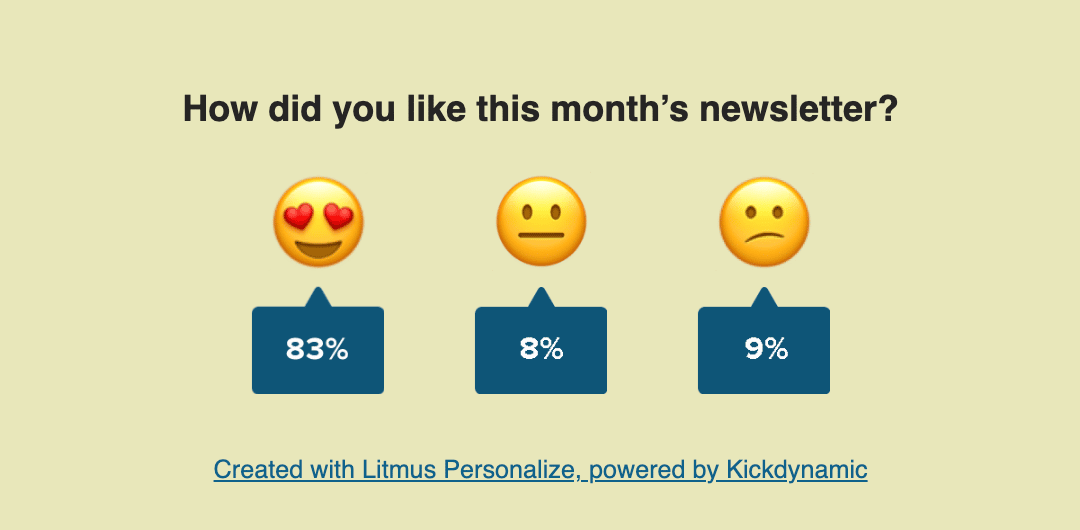Email Debrief: Marketing and Design Trends
Welcome to our new monthly blog series where I, your humble Senior Community Evangelist, recap our latest Litmus Talks and note key takeaways (and offer a few thoughts of my own) to occupy your precious brain space.
This month, I’m sharing my thoughts on email marketing and design trends submitted by email geeks for “Email Marketing Trends in Focus for 2023.” Hosted by Litmus’ Director of Email Marketing Jaina Mistry and our own email designer Hannah Tiner, this virtual event featured conversations with Anne Tomlin of Emails, Y’all from the email developer end, and Aaron Beatty of Engage Evolution to offer an email marketer point of view.
Read on (or jump ahead!):
BIMI is the newest way to visually build trust in the inbox
It could be said that email marketing is a functional exercise in building relational trust. Brand Indicators for Message Identification (BIMI), where you see a verified brand’s logo next to their email in your inbox, is about building and reinforcing trust with our subscribers. BIMI is currently supported by Apple Mail, Gmail, and Yahoo, which accounts for almost 92% of email client market share as of December 2022.

Our experts say:
- Make sure you’re using a clear and simple version of your logo. Text is unlikely to be very legible at that size, so stick with the icon portion of your logo and work with your designers to develop a version that works in that square, if you don’t have one already.
- There is a cost to getting BIMI set up. But considering how much of deliverability these days is based on sender authentication, it seems eminently worthwhile to invest in getting it set up for your brand.
💭 Is BIMI worth implementing?The more confident your subscribers are that it is indeed you sending them an email, the less friction there will be in opening, reading, and engaging with your content—which is good for everyone, especially in a world where phishing and email scams are on the rise. BIMI’s just the latest way of continuing to nurture that confidence. If a majority of your subscribers’ email clients support it, it will be worth the time and money to set it up. |
More email marketing role specialization means more value
Fighting to convey the complexity and labor of email marketing work is such a common experience across our community. Seeing the shift from email being one of many responsibilities for a marketer to the development of specialist roles feels like email finally being given its due.
Here’s what our experts think is particularly noteworthy:
- Email developer roles are being posted every day, with remote work being the standard, all of which are positive signs.
- There’s still a supply and demand issue. Trying to find people with in-depth knowledge can be a challenge. We’ll also see email marketers asked to flex outside of email into social, SMS, and other forms of engagement.
- Being able to specialize in email as a designer allows focus on email as a discrete design medium, which makes for a higher quality of work.
- There’s a clear line from the pandemic and recession to email becoming the primary marketing channel for many companies because of its high return on investment (ROI), to those companies investing more into their email programs, to driving more innovation as a result, to the creation of more niche roles.
💭 What about being a well-rounded email marketer?It’s helpful to have a broad knowledge base, but role specialization represents a great step forward in how the skillset of an email marketing professional is being more properly valued in the larger marketing industry. The fewer hats we have to wear, the more we can focus on the quality of the work, the better it is for us, our companies, and our subscribers. |
Hyper-personalization is the latest iteration of an evergreen trend
We have a long-held association of personalization being the very basic use of first names—which is due for an update.
Hyper-personalization as a term is merely the way we try to describe the need for deeper connection with subscribers, beyond the first name.
Here are recommendations from our experts on how to approach hyper-personalization:
- Reframe personalization. What are the things I can talk about with our subscribers that are specific to their experience of my company?
- Collaborate between customer relationship management data teams and email teams needs to be happening much earlier in the process, because the medium affects what’s possible with personalization as much as what data we have available.
- Dynamic content has surpassed first name personalization for many companies.
- Keep the big picture in mind when organizing your data. Understand that consolidating sources of data will speed and ease the development process.
💭 Why is personalization always a trend?You might be thinking, “Personalization always seems to be on the email marketing trends list.” That’s a very understandable response. Personalization will be a trend as long as human beings are the ones reading email. While relevance will be a moving target that is always worth our energy to try and hit, the practice of personalization overall reflects the evergreen human need to feel seen and known. |
Will AI start to influence email marketing content?
In 2021, we reported that 70% of brands were increasing email marketing work, but budgets have largely stayed the same. Is that where AI comes in as a tool?
Our experts weigh in with a range of perspectives:
- These services potentially raise everyone’s game. You can give an AI service a prompt and receive content that you can then tweak to be good enough to use.
- There’s a quality gap. AI-produced images are pixel-based, not vector, which limits their utility.
- There are ethical concerns. Many conversations in design spaces right now focus on how AI services are trained and the replication of biases, as well as how they themselves rely on real designers’ work, raising concerns about plagiarism.
💭 Is this the best use of AI tools?On one hand, AI content creation services can potentially be helpful for time- or resource-strapped marketers (and your humble recapper has yet to meet a marketer with enough time). On the other, the very real ethical questions around their use of human-created work to learn, the potential for bias in how content is presented, and the overall impact of these services on how we value actual human creative output brings into question whether we want to support this as the way that AI tools develop. There are many ways AI could automate and assist us that wouldn’t involve potential plagiary, bias, and devaluation of human creativity. |
More interactivity in emails
Interactivity generates twice as many conversions as static content, according to Demand Metric, and Dyspatch says that 50% of email recipients said they want to interact more with content inside their email.
Here’s what our experts say about interactivity:
- Email marketers want to create a memorable experience. Interactivity—hover effects, image carousels, polls, AMP—can be seen as a key method for doing just that.
- No one has to start from scratch. There are so many examples and tutorials online, and as Alice Li has mentioned in the past, hover states are a great interactive refinement to an email that take very little time to implement.
- “Is the juice worth the squeeze?” It’s worth putting in the due diligence to figure out your subscribers’ email clients and what sorts of interactive elements are supported, and then to figure out if the addition of those elements is generating what you need from an email.
💭 Does interactivity have to be a major effort?Deciding whether to invest in interactivity within your emails is always going to come down to knowing what is supported in your subscriber’s email clients and whether you or your team has the additional bandwidth to devote time to it. However, if it makes sense for your audience, there are many examples and options of adding interactivity with low effort. |
Sentiment polls measure engagement and emotional response
It’s less tangible in some ways than clicks and opens, but a sentiment poll is a great way to know if a subscriber is enjoying the content they’re seeing.

Our experts advise us on what to keep in mind with sentiment polls:
- Helpful for long-form newsletters where there are no click-away calls to action.
- Make it very clear what the user is expected to do. Avoid ambiguous rating scales.
- Pick a style that fits with your visual brand, and consider where you want to place it in your content hierarchy.
💭 Why should we care about sentiment?In a post-Mail Privacy Protection (MPP) world, we’re looking for new ways to measure engagement and know whether our content is connecting with our subscribers. Sentiment polls can be a straightforward, easy to implement method of gathering an emotional response from our subscribers, and gauging the level of satisfaction with our content overall can be important data to have on hand when reforming or improving our email programs. |
Two approaches, one goal: accessibility and usability
Honestly, accessibility is less of a trend at this point and more of an expectation. At its core, it’s simply acknowledging that people experience the world in a much broader range of ways than we’ve traditionally credited. From that perspective, usability connects seamlessly with accessibility when we ask, “Usable for whom?”
Here’s what our experts say to keep in mind when it comes to accessibility and usability:
- Consider accessibility at the beginning of your content strategy rather than assessing it at the end.
- It should be easy for subscribers to find the relevant information in even the most content-packed emails, know where to click and what that click means.
- There are many ways to craft a cohesive experience for the reader, from breaking up content into distinct sections to creating clear calls to action, using bullet points, and writing descriptive sub-headers.
- The more you follow accessibility best practices when coding, the more usable your email is going to be. Developing emails that work with different assistive technologies and devices people with visual, cognitive, or motor disabilities utilize is about making them usable.
- ALT text is intended for describing the look and feel of images, and is not a replacement for live text content.
💭 How can we make people’s lives better in a tangible way?If we’re working to make our content a good user experience for our subscribers, then that also means making it accessible. The more work we do to make our content strategy inclusive by considering these needs on the front end, the less work we make for ourselves by trying to change it later to accommodate. It’s also a practice which has an unambiguously positive impact on real people, which isn’t always easy for us to see in our day-to-day work. |
Minimalism is the great connector
This style of design enables and complements several of the trends mentioned previously.
Our experts offer these thoughts on minimalism:
- Minimalism complements usability and accessibility practices.
- This design approach allows content to take center stage, and can also help encourage concise copywriting and increase legibility across multiple devices by stripping away stylistic elements that may distract.
- Depending on your brand’s visual style it may not be appropriate, as visual consistency and cohesion across your branding is quite important.
💭 Is this just a design fad?Design is about creating solutions to needs. Minimalism meets a number of tangible needs for today’s email marketer—allowing for modularity to accommodate dynamic content, increasing the ease with which content is comprehended, and translating content comfortably across a range of devices. In short, as long as it can jive with your visual brand, there’s no reason not to embrace this approach. |
Will you embrace (or ignore) these trends?
Leaning into trends is a great way to help you stay relevant with your subscribers. Will you be embracing—or ignoring—the email design and marketing trends?
Download our latest ebook for eight email marketing and design trends you should know.

Logan Sandrock Baird
Logan Sandrock Baird was the Senior Community Evangelist at Litmus
